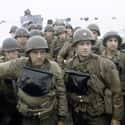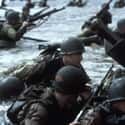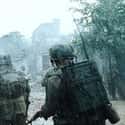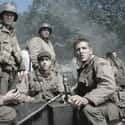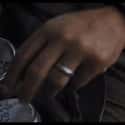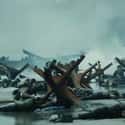-
(#5) The Soldiers In The Movie Wore Unfastened Helmets
Throughout Saving Private Ryan, soldiers are shown wearing helmets with chinstraps either hanging by the sides of their heads or fastened in the back. During WWII, it was common for men to leave their M1 helmets - made of an outer steel shell and an inner liner - unfastened due to concern among soldiers that a chinstrap would be dangerous in an explosion. The fear was that the force from the blast would blow one's helmet back, breaking the wearer's neck in the process.
It was reported that General George S. Patton even ordered men to leave their helmets unfastened after one of his aides perished in Tunisia in this exact manner.
-
(#1) Heavy Equipment Made It Incredibly Hard For The Landing Forces To Get Solid Footing
The struggle to get to shore on D-Day was multifaceted. Heavy gear, equipment, and supplies weighed soldiers down, while constant artillery fire threatened every move. As 20-year-old Ted Cordery watched on, he saw several soldiers never even get to the beaches of Normandy, succumbing to the English Channel instead.
Saving Private Ryan accurately shows troops let off into water that was too deep for them to touch the ground. Cordery recalled decades later:
I felt so sorry for the men. They were coming from a fair way out to get to the beach, and they were all in their uniforms and carrying guns and their own food, so they all had these cans weighing them down... So many of them didn't make it because they were dropped too far from the land. They went straight in the deep water and drowned.
-
(#8) They Opted For Very Subtle Military Jargon
In many war movies, the language used among soldiers is altered for the audience. For example, Captain Miller (Tom Hanks) calls "CATF" into the radio several times, which is short for "Commander, Amphibious Task Force." The audience may not know the meaning of the acronym, but it is authentic military terminology and reflects actual communication that would have taken place between men in the field and the individual in charge of an amphibious operation.
As another example, it's common to say someone was killed in combat, a civilian expression that's found its way into movies and television. Terminology like KIA is more appropriate among soldiers, and that's what one hears in Saving Private Ryan.
According to Dale Dye, a military consultant on Saving Private Ryan, "That's how real soldiers talk... and the audience gets it." Steven Spielberg wanted to embrace straightforward military speak, really enjoying terms like "defilade," which, according to Dye, "refers to the angle of the weapon and its beaten zone." Essentially, the "defilade" position is an area within which you can't get hit by someone firing at you.
-
(#10) Matt Damon Was Kept Separate From The Rest Of The Cast To Create Real Onscreen Animosity
The cast of Saving Private Ryan went to boot camp in anticipation of the movie, a grueling 10-day training program overseen by military consultant and former Marine Dale Dye. Boot camp meant long marches, little sleep, and harsh conditions - all of which made Tom Hanks want to quit after four days.
Matt Damon, however, was exempt from the boot camp, a deliberate choice by director Steven Spielberg. Since Damon was portraying Private Ryan - the individual at the heart of the mission undertaken by Hanks's character and others - he was set apart from the rest of the group. This fostered animosity and resentment with his cast members that could be captured onscreen as the tension that would necessarily exist between Ryan and the soldiers sacrificing themselves for a lone brother-in-arms.
For his part, Damon did take part in separate training exercises.
-
(#12) Soldiers Often Collected Dirt As A Symbol Of Where They'd Served
Tom Sizemore's character, Sergeant Horvath, is seen gathering soil from France and placing it in a tin. When he puts the small container in his bag, there's a glimpse of similar tins labeled Italy and Africa, indicating he's collected dirt and sand from those locations, as well.
What Horvath does in Saving Private Ryan was common for WWII soldiers. Many men who served took home souvenirs. Talismans like soil, seashells, and rocks taken from the places they served functioned as a special reminder of survival. Such items could also become a source of good luck.
When Frank Gagliano, a member of the 101st Airborne who stormed Omaha Beach on D-Day, revisited Normandy decades after the invasion, he actually grabbed some sand to take home with him. Gagliano noted, "I didn't think to do it the first time... I was too busy trying to stay alive."
-
(#3) The Anti-Seacraft 'Czech Hedgehogs' In The Water At Normandy Reflect One Of The Miscalculations Made By The Germans
The presence and placement of Czech hedgehogs at Normandy - crossed bars of iron or steel welded into spiky obstacles - gives insight into preparations for the invasion by the Germans. Often used to disable tanks, the Czech hedgehogs were an ideal defense against landing vessels, as well. When underwater, approaching boats and ships would be struck.
Germany believed the invasion of Normandy by Allied Forces was going to take place at high tide. The Allied Navy and Army, however, opted to begin their approach in the early morning hours of June 6, 1944, when the tide was low. This gave them time to disable some of the underwater defenses installed by the Germans.
New Random Displays Display All By Ranking
About This Tool
Our data comes from Ranker, If you want to participate in the ranking of items displayed on this page, please click here.

